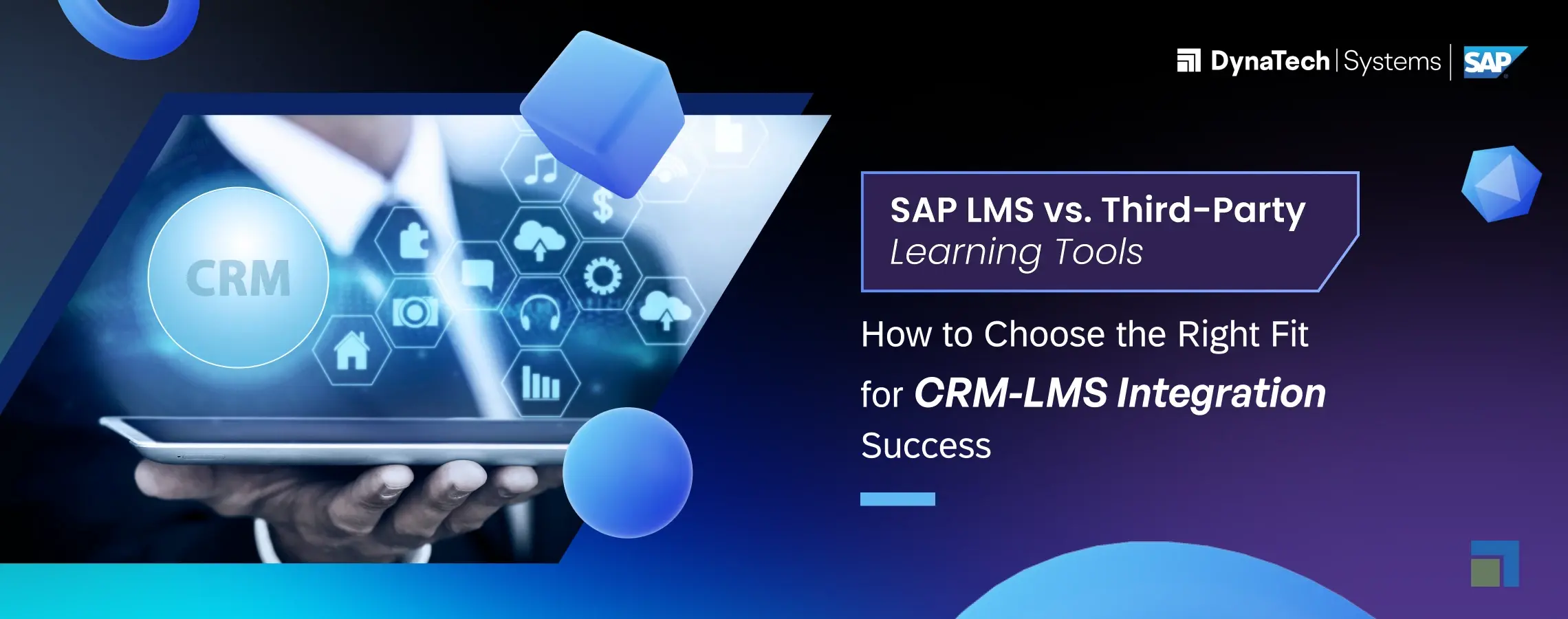The Learning Dilemma No One Talks About
Modern organizations are spoiled for choice—and simultaneously paralyzed—when it comes to choosing a Learning Management System (LMS). On one end of the spectrum, robust enterprise-grade platforms like SAP SuccessFactors Learning Management System offer unmatched integration and governance. On the other, agile and specialized third-party LMS platforms promise faster deployment and lower upfront costs.
So, how do you pick? Especially when you're investing not just in a learning platform but in a solution that must scale, sync with your CRM, serve your users—whether they’re employees, partners, or association members—and future-proof your training programs?
This blog tackles the debate head-on—through strategic comparisons, integration benefits, real-world use cases, and a crisp breakdown of the Litmos SuccessFactors differences.
Why LMS-CRM Integration Is More Than Just a Feature
In 2025, the global corporate LMS market is projected to exceed $38 billion. Yet nearly 46% of enterprises say that poor system integration between their LMS and CRM systems results in fragmented learning journeys and reduced training ROI.
Let’s examine the top Benefits of CRM-LMS Integration:
|
Benefit |
Description |
|
Unified User Data |
Learner progress, certification status, and role-based access mapped directly to CRM profiles. |
|
Sales & Partner Enablement |
CRM triggers customized learning paths for leads, customers, and resellers. |
|
Analytics-Driven Decisions |
CRM data fused with LMS reports enables predictive learning analytics. |
|
Personalized Learning |
Marketing automation in CRM tailors learning campaigns based on learner behavior. |
When done right, the benefits of integrating LMS with CRM systems using SAP Integration Services go beyond convenience—they create a competitive edge.
LMS Comparison: SAP LMS vs. Third-Party Tools
Let’s compare enterprise-grade LMS platforms like SAP SuccessFactors with some of the top third-party LMS options.
|
Criteria |
SAP SuccessFactors LMS |
Third-Party LMS (e.g., TalentLMS, Docebo, Absorb) |
|
Integration Depth |
Native integration with SAP modules |
API-level or connector-based |
|
Enterprise Control |
Strong compliance and audit trails |
May lack full regulatory controls |
|
Customization |
Extensive but complex |
Easier UI-based customization |
|
Cost |
Higher TCO |
Varies, usually subscription-based |
|
Time to Deploy |
6–12 months (Avg. for SAP clients) |
2–6 weeks (Avg. for SMBs) |
|
Scalability |
Enterprise-grade |
Depends on provider |
If your organization already uses SAP ERP, SAP HCM, or SAP S/4HANA, partnering with an experienced SAP SuccessFactors Implementation provider can ensure seamless deployment and higher ROI long-term.
However, if agility and quicker rollouts are your priority, third-party LMS tools could offer better speed and flexibility.
Use Case: Best LMS for Association Member Training
Associations, non-profits, and unions have unique needs—they’re not just training staff, but also engaging members, volunteers, and stakeholders across varied geographies.
Here’s what defines the Best LMS for association member training:
- Multi-language Support
- Gamification & Microlearning
- Mobile-first Design
- Tiered Access for Members vs. Volunteers
- CRM Integration for Membership Tracking
In this scenario, many associations benefit from third-party LMS platforms with Salesforce or Dynamics 365 CRM integration.
At DynaTech, we’ve empowered nonprofit clients with custom CRM-integrated LMS portals, allowing self-paced learning, automated course recommendations, and integrated donor onboarding paths.
Litmos SuccessFactors Differences – Clearing the Confusion
SAP offers two distinct LMS solutions—Litmos and SuccessFactors Learning—and the differences are more than just branding.
|
Feature |
SAP Litmos |
SAP SuccessFactors Learning |
|
Target Audience |
SMBs, Agile Enterprises |
Large Enterprises |
|
Deployment |
Cloud-based, ready-to-use |
Full-suite integration with HR, HCM |
|
Interface |
Intuitive, learner-first |
Complex but highly configurable |
|
Integration |
Out-of-the-box connectors |
SAP-native with full compliance workflows |
|
Custom Content |
Drag-and-drop content tools |
Deep SCORM/xAPI/LTI support |
|
Ideal Use |
Customer & partner training |
Internal workforce development |
In essence:
SAP Litmos is lightweight, cost-effective, and best for partner/customer education.
SAP SuccessFactors Learning is comprehensive, scalable, and suited for complex internal HR training.
Pro Tip: If you’re using D365 CRM and planning member or partner training—SAP Litmos + CRM integration is an agile combo we’ve implemented with success.
Key Decision Factors: Making the Right LMS Investment
Before you finalize your LMS platform, consider these strategic questions:
- What’s your primary audience—internal employees or external stakeholders?
- Do you need LMS content to sync with CRM workflows, marketing journeys, or customer onboarding?
- Are regulatory compliance and audit trails a major concern?
- Do you already have SAP infrastructure? Or is your tech stack more Microsoft/Oracle/third-party heavy?
- What’s your deployment timeline and TCO appetite?
According to Deloitte, companies that optimize LMS-CRM integrations experience 22% faster employee ramp-up time and 30% higher customer satisfaction. Engaging expert SAP Consulting Services can further guide organizations in aligning their LMS strategy with broader business goals.
Conclusion: LMS Isn’t Just a Tool—It’s a Business Enabler
An LMS can either be a disconnected course library—or a strategic powerhouse that drives performance, engagement, and transformation. The key is choosing a platform that doesn’t just check off features, but works in tandem with your existing systems like CRM, HR, and analytics.
At DynaTech, we specialize in building seamless learning ecosystems—whether you choose SAP SuccessFactors LMS, SAP Litmos, or a third-party LMS like Docebo or Moodle. Our solutions focus on deep CRM integrations, personalized learning journeys, and automation-ready implementations that save time and deliver results.
.png)






